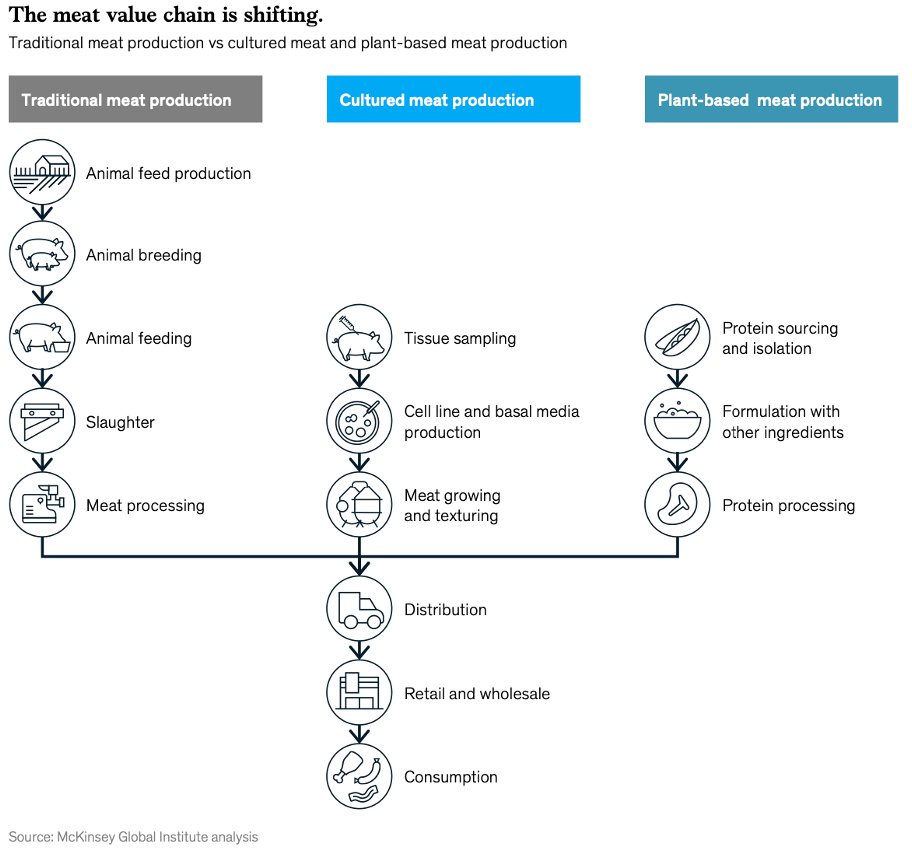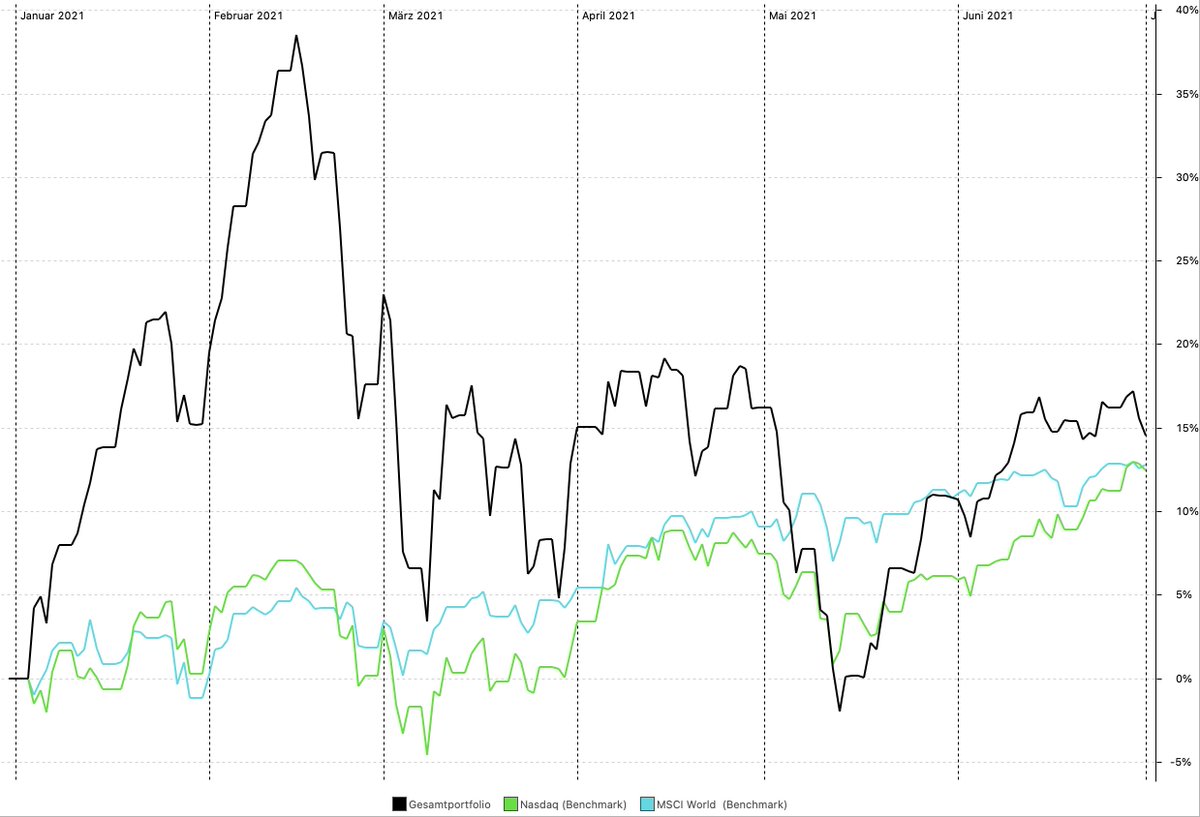
- Thread The Bio Revolution -
McKinsey published a 200-pages report on the impact of biotech in May earlier this year and I want to summarize the most important points for you today.
Feel free to reach out and I will send you the whole report.
McKinsey published a 200-pages report on the impact of biotech in May earlier this year and I want to summarize the most important points for you today.
Feel free to reach out and I will send you the whole report.

1) Introduction
Lately, there has been a sharp drop in the cost of sequencing DNA and emerging technologies to edit genes and reprogram cells have helped to increase innovation. Scientists suggest that 60% of physical inputs in the global economy could be produced biologically.
Lately, there has been a sharp drop in the cost of sequencing DNA and emerging technologies to edit genes and reprogram cells have helped to increase innovation. Scientists suggest that 60% of physical inputs in the global economy could be produced biologically.

Of this 60%, 1/3 are biological materials and 2/3 aren’t but could be produced or substituted using biology. 45% of the current global disease burden could be addressed using science that is conceivable today. Combining all the use cases that are available today 

would make up for an economic impact of up to $4 trillion a year over the next 10-20 years and that doesn’t even include applications that haven’t yet emerged. However, 70% of the potential impact depends on social attitudes towards technologies and regulations of governments. 

2) 4 arenas
There are innovations happening in 4 main arenas: biomolecules (mapping, measuring and engineering of molecules), biosystems (engineering of cells), biomachines (interface between biology & machines), biocomputing (use of cells/molecules such as DNA for computation)
There are innovations happening in 4 main arenas: biomolecules (mapping, measuring and engineering of molecules), biosystems (engineering of cells), biomachines (interface between biology & machines), biocomputing (use of cells/molecules such as DNA for computation)

3) Agriculture
The human population is growing quickly and providing food for everyone might be one of the greatest challenges that humans face. Biotech is responsible for many innovations in this field, and we will talk about the two stages of genetically modified food.
The human population is growing quickly and providing food for everyone might be one of the greatest challenges that humans face. Biotech is responsible for many innovations in this field, and we will talk about the two stages of genetically modified food.

The first wave of genetically engineered crops (GMOs) are organisms with foreign genetic material. After the emergence of CRISPR highly specific cisgenic changes and intragenic changes are possible. Crops can be engineered to be tastier and more heat-resistant which will be more 

important with increasing climate change. Today genetically modified crops make up about 12% of cropland. Furthermore, the US FDA has declared that it will not regulate the plants if editing does not lead to foreign DNA. Other innovations include e.g. lab-based food
which is significantly more sustainable than traditional food. The direct annual impact of biology in this sector is expected to be $800b-$1.2t over the next 10-20 years. Acceptance of consumers will be key to the success of genetically modified food. 

3) Consumer products and services
The availability of biological data opens the opportunity to personalize products and services based on the DNA of the customer.
The availability of biological data opens the opportunity to personalize products and services based on the DNA of the customer.

Some potential application areas are in healthcare, beauty products based on microbiomes, and innovative approachesto wellness and fitness. Companies can now analyze the DNA and design a product/service that perfectly fits the customer’s needs.
This will play a big role in professional sports as every competitive advantage that can be created is important in this field. The expected annual impact is $200bn-$800bn. 

4) Production and energy
Improved fermentation processes increase the speed of production and/or quality of materials. Furthermore, there is progress in the energy sector with greater use of biofuels and improving energy extraction and storage.
Improved fermentation processes increase the speed of production and/or quality of materials. Furthermore, there is progress in the energy sector with greater use of biofuels and improving energy extraction and storage.

5) Effects that aren't even included
The impact of applications could have knock-on effects on the broader economy. One example is that more healthy lab-based food leads to improved health which leads to people living longer which leads to more demand for eldercare.
The impact of applications could have knock-on effects on the broader economy. One example is that more healthy lab-based food leads to improved health which leads to people living longer which leads to more demand for eldercare.

6) Important risks
Biology is self-replicating, self-sustaining, and doesn’t know jurisdictional boundaries. Furthermore, genetically engineered gene drives might have great health benefits but are hard to control and could also dramatically damage ecosystems.
Biology is self-replicating, self-sustaining, and doesn’t know jurisdictional boundaries. Furthermore, genetically engineered gene drives might have great health benefits but are hard to control and could also dramatically damage ecosystems.

Most different sectors in biology are highly interconnected and changes in one part of the system influence all parts and could have unintended consequences. The entry costs are very low which could lead to misuse - bioweapons and biohackers are impossible to control and kits
to perform CRISPR gene editing are sold on the internet and accessible to everyone.
Different value systems and moral understanding make it hard to form a consensus on where the barriers and limits should be.
Different value systems and moral understanding make it hard to form a consensus on where the barriers and limits should be.
Important ethical questions are arising as well (e.g. editing out disabilities before birth or choosing baby’s skin color). Moreover, unequal access could lead to socioeconomic disparity and discrimination which would lead to a lower acceptance rate in society.
Regulations will be important to ensure safety but monitoring developments in science and adjusting regulations accordingly are even more important. National regulations won’t be sufficient as biology doesn’t know borders (as we all experience during COVID).
One of the main problems is that most regulators aren’t scientists and aren’t able to adjust regulations accordingly to the latest developments. There are serious privacy concerns as well as the data collected comes directly from the DNA and couldn’t be more personal.
7) Commercialization
Once the stage of scientific research is finished, commercialization and diffusion can begin. 4 factors that determine the journey from lab to market and ultimately the success:
Once the stage of scientific research is finished, commercialization and diffusion can begin. 4 factors that determine the journey from lab to market and ultimately the success:

a) Does the product/service offer a value proposition to end-users?
- products compete on price and quality
b) Is the business model suitable in a fast-changing landscape?
- Biotech is driven by innovation and companies must be able to adapt to new technologies quickly
- products compete on price and quality
b) Is the business model suitable in a fast-changing landscape?
- Biotech is driven by innovation and companies must be able to adapt to new technologies quickly
c) Ensuring new products/services get to the right potential customers
- important to define the target group and reach them efficiently
d) Ability to scale up operations
- companies need the right infrastructure, knowledge & supply chain
- important to define the target group and reach them efficiently
d) Ability to scale up operations
- companies need the right infrastructure, knowledge & supply chain
8) Adoption rate
The adoption rate is expected to vary between different sectors. Human health is expected to have the highest rate of adoption as it directly improves the quality and length of lives.

The adoption rate is expected to vary between different sectors. Human health is expected to have the highest rate of adoption as it directly improves the quality and length of lives.


9) Neuroprosthetics
Neuroprosthetics connect the human nervous system to computers and furthermore not only providing control of prosthetic limbs but also restoring lost sensory function.
Neuroprosthetics connect the human nervous system to computers and furthermore not only providing control of prosthetic limbs but also restoring lost sensory function.

Would highly appreciate thoughts/feedback/opinions :)
@PelotonHolder @RamBhupatiraju @JonahLupton @NatHarooni @camiadeluca @mw_stocks @SixSigmaCapital @InvestmentTalkk @Ryan_Burgio @plantmath1 @JoTrader4 @mavix_leon @Prof_Kalkyl @LiviamCapital @InvestiAnalyst @Invesquotes
@PelotonHolder @RamBhupatiraju @JonahLupton @NatHarooni @camiadeluca @mw_stocks @SixSigmaCapital @InvestmentTalkk @Ryan_Burgio @plantmath1 @JoTrader4 @mavix_leon @Prof_Kalkyl @LiviamCapital @InvestiAnalyst @Invesquotes
@dhaval_kotecha @BrianFeroldi @mukund @GrowthStockDoc @DocCapital @rhemrajani9 @GetBenchmarkCo @alexroznowski @Varro_Analytics @NeuroStockDoc @sbarnettARK @trevmuchedzi
• • •
Missing some Tweet in this thread? You can try to
force a refresh







